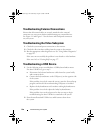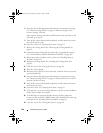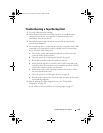
154 Troubleshooting Your System
Troubleshooting System Cooling Problems
CAUTION: Many repairs may only be done by a certified service technician.
You should only perform troubleshooting and simple repairs as authorized in
your product documentation, or as directed by the online or telephone service
and support team. Damage due to servicing that is not authorized by Dell is
not covered by your warranty. Read and follow the safety instructions that
came with the product.
Ensure that none of the following conditions exist:
• System cover, cooling shroud, drive blank, memory-module blank,
power-supply blank, or back filler bracket is removed.
• Heat-sink blank is removed (in single-processor configurations).
• Ambient temperature is too high. See your
Getting Started Guide
for
your system’s operating temperature requirements.
• External airflow is obstructed.
• Cables inside the system obstruct airflow.
• An individual cooling fan is removed or has failed. See "Troubleshooting a
Fan" on page 154.
• The expansion card installation guidelines have not been followed. See
"Expansion Card Installation Guidelines" on page 114.
Troubleshooting a Fan
CAUTION: Many repairs may only be done by a certified service technician.
You should only perform troubleshooting and simple repairs as authorized in
your product documentation, or as directed by the online or telephone service
and support team. Damage due to servicing that is not authorized by Dell is not
covered by your warranty. Read and follow the safety instructions that came
with the product.
1
Turn off the system and all attached peripherals.
2
Open the system. See "Opening the System" on page 85.
3
Locate the faulty fan indicated by the LCD panel or the diagnostic
software.
4
Reseat the fan's power cable.
book.book Page 154 Wednesday, August 19, 2009 4:40 PM


















